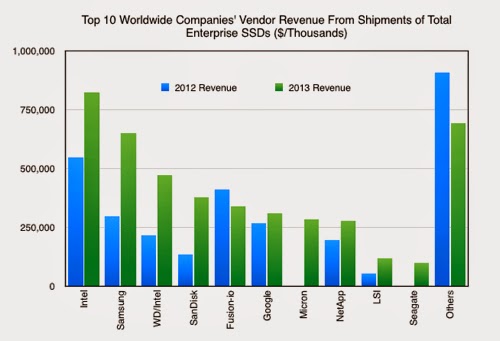The market of
embedded flash controller grew from $6 to 9.5 Billion between 2012 to 2013 (see
the article below).
The article does not elaborate on the large increase of market
share by Hynix and Toshiba. Hynix gain market share from 6.3% to 22.5% while
Toshiba from 18.7% to 22.5%.
|
2013 Rank
|
Company
|
2012 Share
|
2013 Share
|
|
1
|
Samsung
|
56.6%
|
35.6%
|
|
2
|
Toshiba
|
18.7%
|
22.5%
|
|
3
|
SK Hynix
|
6.3%
|
22.5%
|
|
4
|
SanDisk
|
15.5%
|
14.0%
|
Wondering
what is the cause for Hynix $1.68 Billion growth? It will be interesting to
compare to the market share of the overall Flash NAND memory market shares. Is
Apple behind Hynix growth?
Interesting
to see today news that Quarterly
Profits of Samsung Electronics Forecast to Drop
“IT & Mobile Division, which accounted for
over 60 percent of the electronics giant’s sales and business profits last
year. The division’s smartphone and tablet PC shipments are estimated to have
declined significantly in the current quarter. “According to our forecast,
smartphone and tablet PC shipments have fallen at least 10 percent and
approximately 20 percent from the preceding quarter, respectively,” said
research analyst Song Myung-sup at HI Investment & Securities”
Ron
Insightful, timely, and accurate semiconductor consulting.
Semiconductor information and news at - http://www.maltiel-consulting.com/
Insightful, timely, and accurate semiconductor consulting.
Semiconductor information and news at - http://www.maltiel-consulting.com/
Janine Love
6/16/2014 05:15 PM EDT
Recently, Gartner
released a report,
"Market Share Analysis: eMMC and eMCP Vendors by Revenue, Worldwide,
2013." The top ranked vendor for eMMC and eMCP market was Samsung
Electronics, with 35.6% of worldwide revenue (around $3.317 billion). The top
four vendors, Samsung, Toshiba, SK Hynix, and SanDisk, claimed 95.4% revenue
share in 2013, up from 90% the previous year. Sales of eMCPs saw higher growth
in 2013 than eMMCs. In the report, Gartner attributes this to the increased
support of eMCPs by application vendors for low-cost smartphones.
Table: Vendor revenue for eMMCs and eMCPs, worldwide, 2012-2013
(millions of dollars).
Officially
known as JESD84-B50: Embedded MultiMediaCard (e.MMC), Electrical Standard
(5.0), eMMC memory is a JEDEC standard that is currently in version 5.0. As
JEDEC defines it, eMMC is an embedded non-volatile memory system that includes
flash memory as well as a flash memory controller. The aim of the standard is
to simplify the application interface design and free up the host processor
from some of the low-level flash memory management tasks. About two years ago,
we saw the introduction of embedded multi-chip package (eMCP) memory, which is
eMMC memory with an additional DRAM module, developed for low-cost smartphones
in an effort to speed time to market.
Figure: Position of different mobile memory systems in relation to
cost and speed.
(Source: Gartner)
(Source: Gartner)
Gartner's
principal analyst, Brady Wang, compiled the report. He found it surprising that
sales of eMCPs saw higher growth in 2013. He also noted that TLC (also known as
3-bits-per-cell) NAND solutions for both eMMC and eMCP will see high adoption
in 2014, both in smartphones and tablets. This will address the market demands
for high levels of storage space while lowering costs.
eMMC
and eMCP memory includes controllers. Some vendors are using their in-house
controllers to gain a competitive advantage.
Wang says: Some NAND flash
vendors, including SNKD, Toshiba and Samsung, still use in-house controllers.
Since the geometry of NAND flash moves fast and also the configurations of NAND
flash chips between vendors are slightly different, it's important to have a
close relationship between controller vendors and chip vendors. That's one
advantage of in-house controllers. The other advantage is the cost.
Despite
the success stories, challenges remain for mobile memory, and Wang identifies
speed and performance as the top ones, as mobile memory is challenged to meet
the demands of high-performance processors. As a result, he expects universal
flash storage (UFS) memory to see its initial adoption in the second half of
2014, but only in very high-end, flagship products to start.
The
advantages of UFS memory (as compared to eMMC/eMCP memory) are better
performance, higher capacity, better bandwidth, better IOPS, and optimized
performance for multithreaded applications, according to Wang. UFS uses a
serial interface (eMMC is a parallel interface) and asynchronous I/O (eMMC is
synchronous I/O), enabling it to efficiently move data between the host
processor and mass storage.
Wang
notes that currently the cost and power consumption of UFS is higher than eMMC,
so this will constrain its adoption. However, with the introduction of
multi-core architectures that require high-performance memory, UFS is well
positioned. “Although the power consumption of UFS is higher than eMMC, its
energy efficiency is better,” says Wang. He expects to see UFS in high-end
smartphones, tablets, and ultrabooks. eMMC will still be the best choice for
mid-to-low cost mobile applications. Wang also points to SATA SSDs as
competition for UFS in ultrabook applications. Finally, he notes that UFS is
not backward compatible with eMMC, which will slow its adoption in applications
where eMMC is already used.







